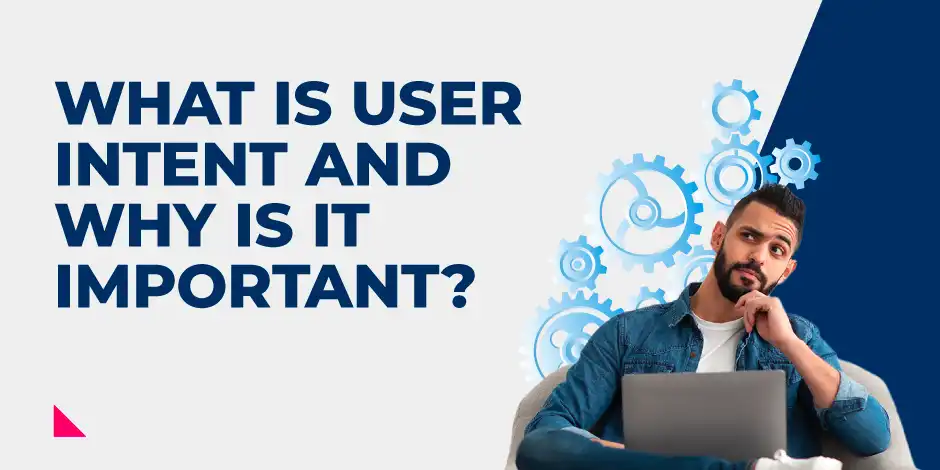
What is User Intent and Why is it Important?
WHAT IS USER INTENT AND WHY IS IT IMPORTANT?
Understanding user intent has never been more important when it comes to perfecting your SEO. According to SmartInsights, Google now processes over 40,000 search queries every second, which translates to over 3.5 billion searches per day and 1.2 trillion searches per year worldwide. And behind every single one of these queries is a searcher with a specific user intent.
TABLE OF CONTENTS
WHAT IS USER INTENT?

When users type a query into Google, they are looking for something in particular, whether it be an answer to their problems, to find information, or to source the specific product or service that they want. With that in mind, if you want your business to be discovered by potential customers, your content must be optimised for user intent.
User intent is what someone is hoping to achieve after typing in their query.
Search engines understand what a person’s user intent is, and as a result, display web pages in the search engine results page (SERP) that are most relevant to what the user is looking for.
In order to help your chances of ranking, it is crucial to understand a person’s search intent and create content with the user in mind. Indeed, creating user-friendly content that meets their intent can give a company a significant advantage over its competitors, which can considerably help to improve a website’s SEO and ranking too.
THE TYPES OF USER INTENT
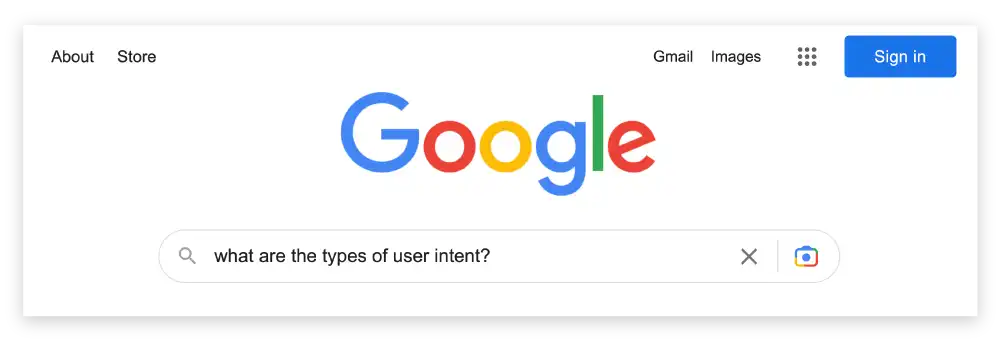
There are said to be four pillars of user intent, and all online content must incorporate (at least) one:
1. Informational: A person wants questions answered/information on a specific topic
2. Navigational: A person who seeks a specific resource, page or site
3. Commercial: A person knows what they want to buy and researches before making a purchase
4. Transactional: A person who is looking to buy something
However, user intent differs from person to person, and for each scenario – bear in mind that not all queries have just one single user intent as it may change as they travel through their user journey. For example, someone may start off wanting informational content, and end up converting to another type of user intent by the end of the blog post, such as commercial or transactional.
Tailoring content for one of these types of user intent is vital to ensure your website is discovered by users and goes hand-in-hand with ranking on Google too. If the content is good and answers the reader’s question, you are more likely to rank higher in the search results.
To find out what kind of search intent your reader would have, you can simply look at the different types of keywords people are using in their search queries. Let’s use a golfing eCommerce client as an example:

So next time you write content for your website, take a walk in your readers’ shoes; think about what questions they may be asking at this point of their user journey. Is the content helpful and engaging, and does it fulfil the user’s goal – to find out some information, research or buy?
For example, you do not want a blog post about the history of golf balls (informational) to rank when the searcher has typed in “buy golf balls”, or simply “golf balls” (both transactional). In this instance, you will have missed out on a potential sale, as the user would have expected to be taken to an e-commerce page and will not click on your blog post.
WHY IS SEARCH INTENT IMPORTANT?
Google only wants to show the user search results that are relevant to them, results that will satisfy their query. Content that Google does not deem relevant will not rank in the search results. With this in mind, creating content that matches the users' search intent is incredibly important for SEO.
Without matching search intent, your hopes of ranking are almost zero.
Once the user has made it to your page, they will only remain there if it matches their search intent. If the page is not what they’re looking for, they will click off the page and head straight back to the search results. If this happens repeatedly, you will end up with a high bounce rate, telling Google your page is not worth showing at the top of the search results.
THE FOUR PILLARS OF USER INTENT
1. WHAT DOES INFORMATIONAL USER INTENT MEAN?
The searcher wants questions answered or information on a specific topic.
At this stage of the user’s journey, the searcher is trying to understand more information about a particular topic, or product before they decide to make a purchase. Typically, these are question-based, such as who, what, where, when, why and how.
From a business perspective, the aim is to identify queries that relate to the product or service your company provides. From this, you will then look to develop content that answers these questions or provides information, which will help to get your business’ website discovered.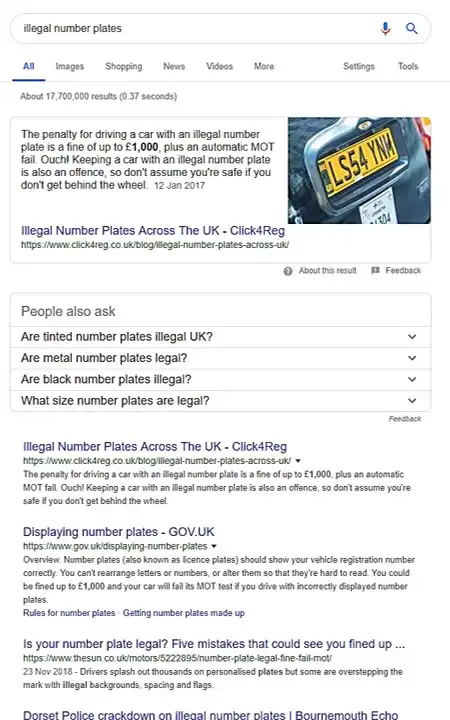
For instance, we have written a post for our client, Ticketgum, about “How to avoid online ticket fraud?”. The aim of this content is to inform sports fans what to look out for to avoid being scammed, which makes the reader trust you and believe you are an expert in your field. The reader may even end up converting to a customer and buying tickets from their website instead – the ideal situation.
But when writing for informational queries, the aim is to create unique content, as your website often competes with hundreds of others. The goal is to get into the top 10 search engine results, and even have some information from your blog post on the featured snippet (see picture for a featured snippet we won for a number plate client, Click4Reg), also known as ‘position zero’. This can be achieved by using relevant buyer intent keywords and writing good posts, so it is vital that you think about the content you are producing for your audience and answer the question properly.
Oliver Sissons, Reboot’s SEO Director, says: "It is worth remembering that even if no sales come as a result of your informational blog, if the content is providing something useful to readers, it will gain backlinks as other people choose to reference the content – whether this is in an article or blog, or via social media".
He adds, "Increased traffic coming to your website as a result of your social media campaigns and sharing your website or blog content on social media can also have several knock-on effects when it comes to your SEO results. If you are putting out interesting and valuable content, high click-through rates are to be expected, which have been proven to have a positive effect on rankings."
2. WHAT DOES NAVIGATIONAL USER INTENT MEAN?
The searcher seeks a specific resource, page or site.
Navigational queries are more specific queries, with the intent of finding a specific website or web page, and are, more often than not, centred around a brand. A navigational query could be seen as an alternative to typing a full URL into your search bar.
For example, “Facebook” is navigational because the intent is to access Facebook. Alternatively, an individual may be searching for a contact page, such as “Reboot Online contact” or even the blog “Reboot Online blog”.
3. WHAT DOES COMMERCIAL USER INTENT MEAN?
The searcher knows what they want to buy and carries out research before making a purchase
Commercial queries often go hand-in-hand with transactional searches, as a commercial query is often to research prior to committing yourself to buying. Therefore, people often type in words such as best, review or compare, in order to get some background research, such as “2019 Cobra Golf Bag Reviews”.
This specific post has commercial intent, as the reader can read and compare different golf bags on the market. This signifies they are at the end of their buyer’s journey and are almost ready to come to a decision about whether they are going to make a purchase. After reading this content, a user may type a transactional term in Google such as “golfsupport golf stand bags”.
4. WHAT DOES TRANSACTIONAL USER INTENT MEAN?
The searcher is looking for something to buy.
Usually at this stage of the buyer’s journey, the search intent is to purchase whatever they have been searching for. For example, search results will be ecommerce landing pages to enable a person to make an enquiry or buy a service or product – not blog posts. For example, if you type in “SEO company” into Google, you will see results for companies offering SEO – no informational content.
But if your business isn’t an e-commerce site, like Reboot, this can be difficult. Instead, a blog post could be designed to push a buyer along in their buyer’s journey, through internal linking. For example, a link to our “SEO services” page tells the reader that we offer SEO services and gives them the option to visit the page and make any enquiries – transactional intent.
OVERLAPPING USER INTENTS
Some search terms don’t fit neatly into one of the four usual categories. They can overlap. This is particularly the case for single word searches, or short queries. For example, if you search the word ‘wood’ into Google you get results that would apply to informational, navigational and transactional searches.
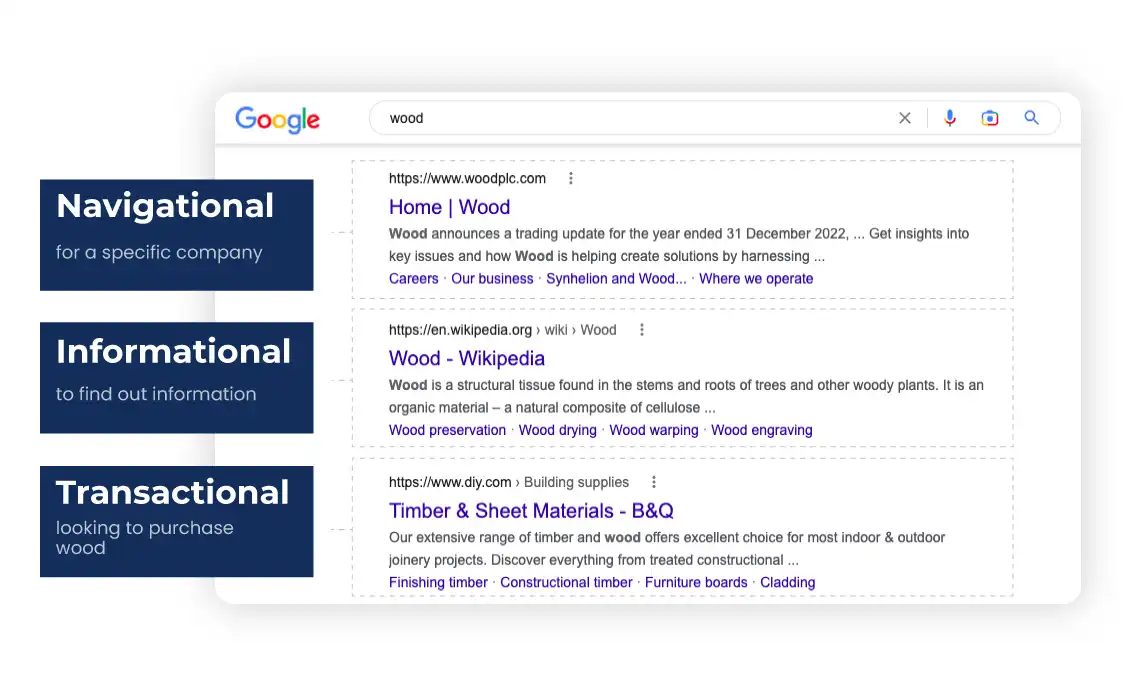
MICROINTENTS
WHAT ARE MICROINTENTS?
Alongside the traditional search intent terms, digital marketers are increasingly using microintents in their strategy to narrow down search terms.
Think of micro-intents as the more specific and nuanced version of traditional search intent queries. By understanding and targeting these micro-intents, marketers can create personalised and relevant content tailored to the specific interests of their audience.
TYPES OF MICROINTENTS
Microintents are an important part of any SEO strategy, allowing for greater accuracy and ultimately greater results for marketers. Here are just a few examples of microintents used in the industry today:
EXAMPLES OF TRANSACTIONAL MICROINTENTS
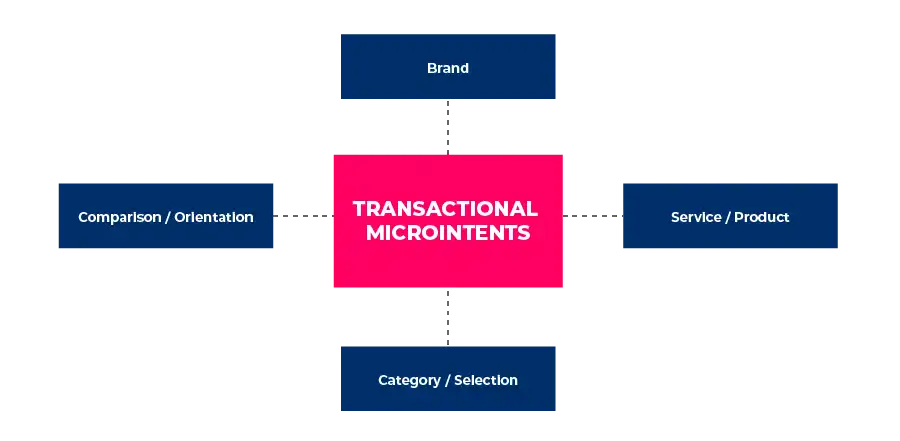
Comparison / Orientation:
When a searcher is planning to buy a product or service and desires to discover the optimal solution, they might seek out ranked listicles, tests, or comparisons to obtain a comprehensive understanding of the available alternatives.
Category / Selection:
When a has a particular interest in a product and service but remains uncertain about which version of a product or service group would be the ideal match, they could peruse conventional shop category pages or service overview pages. The primary focus of the content should revolve around the products and/or services and may be supplemented with information to facilitate the decision-making process.
Service / Product:
When a searcher is aware of precisely what they require and is prepared to make an inquiry or order, but is seeking comprehensive details regarding properties, price, delivery, delivery costs, guarantees, and other related aspects. In such cases, service detail pages and product detail pages are the most suitable.
Brand:
When a searcher is looking for information that builds trust in the brand or provider. Testimonials, customer reviews, and field reports are typical types of content that can serve this search intent.
EXAMPLES OF INFORMATIONAL MICROINTENTS
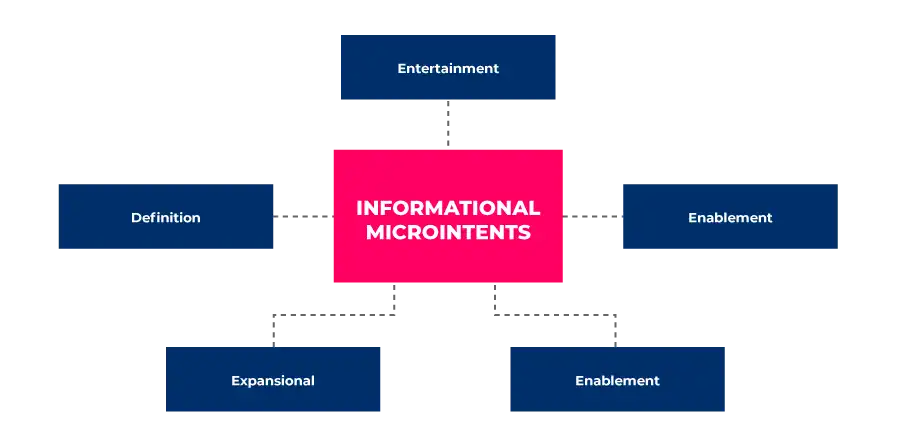
Entertainment:
When the goal of the searcher is to find ways to fill their time and enjoy themselves. Short, easily-consumable content like memes or video clips is a popular option for this microintent, as it can be found and shared directly on social media platforms.
Definition:
When a searcher is seeking straight-to-the-point answers, such as definitions or the importance of a topic, in order to gain a general understanding and determine whether to continue their research. Often these searchers are novices to a topic, turning to snippets in the SERP directly for answers.
Expansional:
When a user is knowledgeable about the subject and wants to explore a topic in-depth. For this microintent, detailed content that presents a comprehensive overview and addresses numerous inquiries is best. In addition to depth and scope, offering new perspectives that aren't often published is also key.
Enablement:
When searchers are seeking to empower themselves by learning how to do ≠≠≠something. Content tailored for this mircointent often features step-by-step instructions on a particular skill. Content for enablement can be tailored to the "How do I...?" keyword in a clear and actionable way.
Aggregation/overview:
When users are seeking an impartial overview of a topic. The content tailored for this microintent should be neutral, brief and straightforward – tables or listicles are a great way to enable easy consumption.
WHY DO MICROINTENTS MATTER?
Microintents are an important process for any SEO and digital marketer as they help understand what your audience is looking for. Going further than standard search terms, micro intents can help marketers understand what your audience is looking for. They’re not only the most granular of the search queries you see in Google and Bing, but they’re also where a lot of your traffic can come from if you optimise content around these terms.
Oliver Sissons, says: "When it boils down to it, understanding microintents and traditional search intent terms is largely the same. Microintents are just a way of classifying search terms on a deeper level – understanding the people behind the search, what they’re searching for, what they need, and using that information to translate to content.”
He adds, “Understanding microintents help with strategy planning, because it allows you to identify clusters and keywords that directly increase traffic that otherwise might not be as obvious.”
WORKING OUT SEARCH INTENT
Despite the usual indicators, it can still sometimes be hard to work out what searchers are really looking for. On occasions, two users may have searched the exact same term, yet in their minds have different intents. One may be looking for information, the other for a purchase. The typical Google user has no understanding of search intent, and rarely when searching do we delineate in our minds the difference between a navigational or commercial search. So how can we really know the intent of our users and why someone might be seeking out our site?
The easiest tool to use is the search engine results page. The search engine results page indicates what people are looking for when they type in the keywords that you are hoping for. Inspecting the SERPs is especially valuable, as it can give you an insight into what other companies are doing well. It will also tell you what kind of sites are ranking for various keywords and varying intents. Researching the SERPs may even open your eyes to new opportunities.
Alternatively, you can simply ask your users why they visit your site. Put a short survey on the site, asking why people visited your site and how they found it. This will indicate what kind of intent you are currently ranking for.
SEARCH INTENT BEST PRACTICES
IDENTIFY USER INTENT
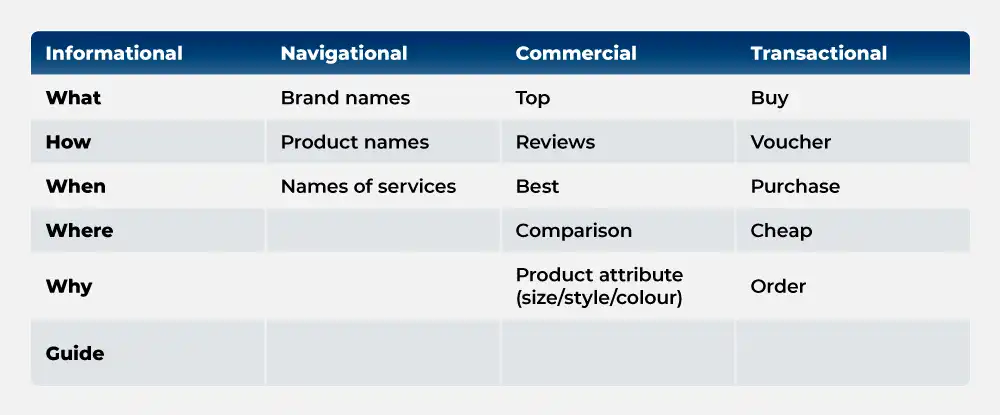
Identify user intent for your keyword(s) before you start writing anything. You can often identify the intent from the words used. For example, informational searches will usually include terms such as: ‘how’, ‘what’, ‘who’, ‘where’, and ‘why’. Navigational searches will mention specific brand names, products, or services, while commercial investigation will look for the ‘best’ or ‘top’ product, brand or service. For the final (transactional) stage, words like ‘buy’, ‘coupon’, and ‘order’ are typically used.
LOOK AT PAGES ALREADY RANKING

Google itself is one of the best tools for identifying user intent. Search your keyword and have a look at the pages that are already ranking. Take a look at the results page below. If you search for the keyword ‘screwdrivers’ and all the pages in the top results are aimed at people looking to buy a screwdriver (transactional intent), then an informational page on how to use a screwdriver is not going to rank.
UTILISE “PEOPLE ALSO ASK…”
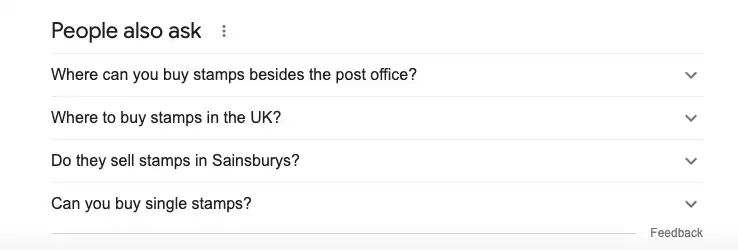
The “People also ask…” section of a search results page is invaluable in SEO. These questions are the other queries the user is likely to search for and are particularly useful for informational pages. Increase the value of your page by resolving not just the initial search query, but also add in the
HOW TO TRANSFORM CONTENT WITH USER INTENT IN MIND
When producing content, you always have to have the thoughts and needs of your user in mind. Google’s aim after all is to direct their users towards the sites that will fulfil their search intent. If looking to re-optimise old content that has failed to rank, ask yourself a series of questions. In the case of an informational page it might be: does this content answer the searcher’s query? You should also consider whether the content is helpful, and presented in a way that is engaging for the user.
In general, your content should be able to balance depth and simplicity. It should cover a broad topic in detail, yet at the same time be understandable for readers of almost all abilities.

However, to do this, you require a strong understanding of your target audience. To create relevant content for them, you first need to have a knowledge of what they really want. The best way to do this, is to conduct prior research. Handy tools for this task include Ahrefs, SEMrush and Buzzsumo. By conducting keyword research on these sites you can get a full picture on what terms have a high search volume and low difficulty. By identifying these high-value keywords, you can then forecast user intent based on the terms that are used, and thus re-adjust your content accordingly.
Regardless of user intent, there are some hard and fast rules which will always enable your content to rank better. All content must include the best SEO practices. Introduce your topic early, and attempt to answer any queries they have in as few words as possible. Then go deeper into the topic. Make use of subtitles and images to break up the content.
Finally, shape your content so that it follows the buyer’s journey. Divide your content into stages through the sale funnel, starting with the awareness stage and later culminating in the action stage. It’s also important to make use of the right calls to action at the right times to keep users engaged with your content.
Ensuring that your site runs smoothly, is simple to use and has an easily navigable design will also improve the ranking of all of your pages.
ADAPTING EXISTING CONTENT FOR USER INTENT
Content can always be updated and improved. And where you have failed to optimise your content for user intent, it is certainly advisable to do so.
To get an idea of where you may have missed the mark on search intent, take a deep dive into your content. Consider the words that you have used. For example if your content features the title ‘how to’, and would therefore be classed as an informational page, but yet fails to answer the question, then the reader is unable to fulfil their goal. This negatively affects the page’s ranking.
The same rule applies if your content features the word ‘buy’ but offers no option for the user to purchase anything.
Should this problem arise, you will need to decide whether to adapt the page itself so it matches user intent, or alter various key terms within the content so it more clearly aligns to a different search intent.
SOME USEFUL KEYWORD INTENT TOOLS
When writing content, whether this be landing page copy, description text or blog posts, keyword research is vital to identify the valuable search terms that your customers or readers are searching for on Google, regardless of their search intent. You can find out more about this in our keyword research guide.
When you create something that your audience likes, people are more likely to link to, engage and share the content more, which is likely to affect search engine rankings and traffic, too. The best SEO is — and for many years has been — a good product, so taking the time to consider your audience intentions when creating a content strategy can pay off in a number of ways.
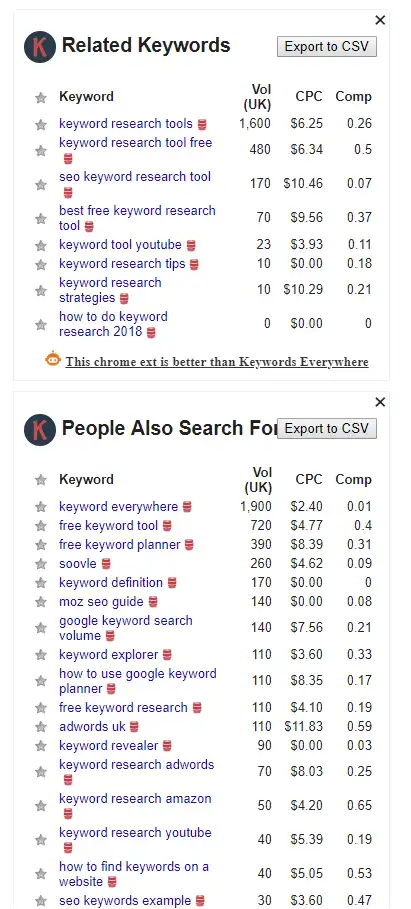
Firstly, tools to help find ideas:
- Buzzsumo
- Answer the Public (Free)
- Google Autosuggest (Free)
Secondly, tools for conducting keyword research:
- AHREFS
- SEM Rush
- UberSuggest (Free)
- Google Autosuggest (Free)
- Keywords Everywhere (Chrome Extension - pictured right)
